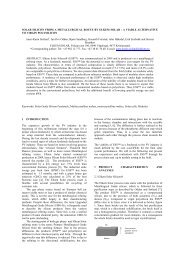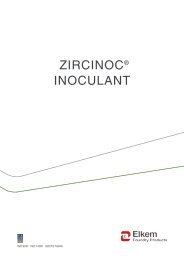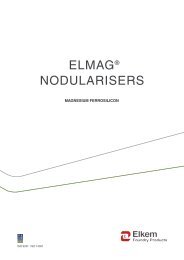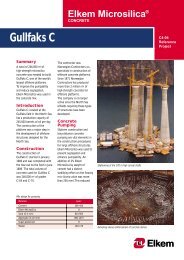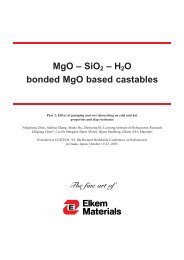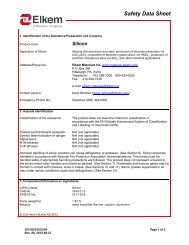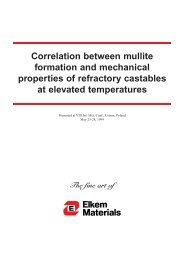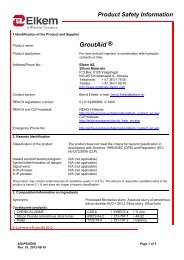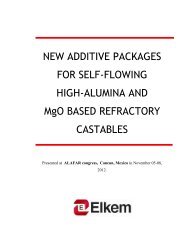Microsilica containing refractory castables - Elkem
Microsilica containing refractory castables - Elkem
Microsilica containing refractory castables - Elkem
Create successful ePaper yourself
Turn your PDF publications into a flip-book with our unique Google optimized e-Paper software.
120100FS20Calgon120100FS20CalgonDarvan 811DSelf-flow (%)806040Self-flow (%)806040202000.00 0.50 1.00 1.50 2.00 2.50 3.00Dosage (mg/m 2 )Figure 6: Effect of dosage of dispersants on selfflowof bauxite-based LCC (number 1&2 in Table2).If Figure 6 and 7 are compared, it is seen that forFS20 the appearance is quite similar, while forCalgon it is in principle similar, but somewhatskewed. There can be several reasons for theslightly distorted shape of the curve for Calgon, butthe first that come into mind is that the phosphatereacts with impurities of the bauxite, thusnecessitating higher dosages than in the purer whitefused alumina system. Further, as also Darvan811D is included, it should be commented.Darvan being a poly-acrylate as opposed to FS20being a carboxylate-ether differs by having apronounced optimum addition level as opposed tothe more flat plateau level that is seen for FS20.This is probably connected to the mode ofstabilisation of colloidal slurries of the twodifferent additives. Darvan is by electrostaticrepulsion, FS20 by a combined steric andelectrostatic mechanism.00 0.5 1 1.5Dosage (mg/m 2 )Figure 7: Effect of dispersant addition on self flowof white fused alumina based <strong>castables</strong> with 6%cement and 8% microsilica, 4.15% water.If we look at the Zeta-potential for the combinationof microsilica and the additives in question thefollowing is found, Figure 8.Zeta-potential (mV)0-10-20-30-40-50-60-70-80-900 0.5 1 1.5 2Surfactant content (mg/m2)FS20Darvan 811DCalgonFigure8: Zeta potential of 10% aqueous slurry ofmicrosilica 971 as a function of dispersant additionexpressed as mg/m 2 microsilica surface.Figure 8 shows the zeta-potential of a microsilicaslurry as a function of dispersant addition. Here,Darvan 811D, Calgon and FS20 have been tested.Two phenomena may be noticed, firstly thelowering (or lack of it) of zeta-potential caused byFS20 indicates that the stabilisation mechanism isprimarily of steric (uncharged) nature. The secondobservation is that there is a good correlationbetween the zeta-potential and the flow. This issuch that the maximum flow appears at, or close to,the point of the relevant zeta-potential curve whereit either attains minimum or, in the case of Darvan,the slope changes abruptly.



